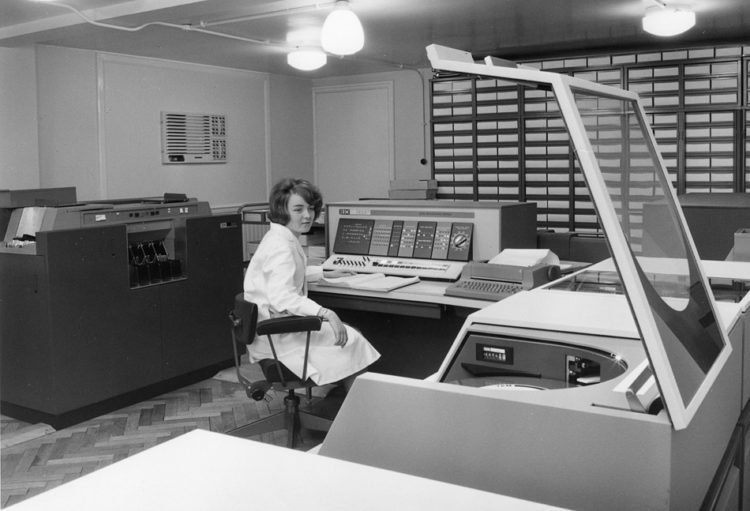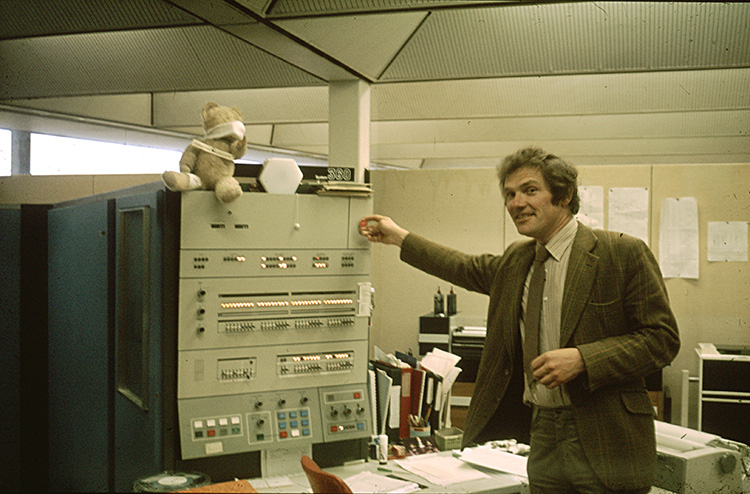A note on the early days of computing in and related to St Andrews University – Part II
It’s World Digital Preservation Day today, with the theme ‘Digits: for Good’. Wishing our colleagues at the DPC and those working to further Digital Preservation within our own institution much success in their endeavours. Here we conclude the story by Professor Jack Cole about the earliest steps towards digital activity in the University of St Andrews., and the people involved.
On the 4th January 1965 the University of St Andrews Computing Laboratory started a full-time computer service in St Andrews. In celebration of its Silver Jubilee in 1990, the Computing Lab issued a special supplement to its newsletter. Below is part II of the article contributed by Professor Alfred Jack Cole (1925-1997). See here for part I.

Early computer staff at St Andrews
At the beginning of October 1965 the staff of the computing service consisted of the newly appointed director, one operator, namely Mrs Sheila Hill, one computer/punch operator, namely Mr David Wishart and the part time services of a secretary. Mrs Hill had been appointed as an operator soon after the installation of the machine and had been responsible for its day to day operation for some months before my arrival. She had already given good service in establishing the independence of the computing service and continued to do so for a number of years. Mr Wishart was appointed just before me. In December 1965, another operator, Miss June McNeil was appointed and in the following month Mr Wishart was promoted to programmer/computer operator.
Further staff changes took place during the year including the resignation of Miss McNeil who left to get married, the appointment of Miss Helen Robertson and Mrs Mollie Imrie as operators, the promotion of Mrs Hill to Senior Operator and the appointment of Mr A J T Davie as lecturer on 1st October 1966. Mr Davie had previously been an assistant lecturer in the Department of Applied Mathematics.
Problems . . .
On my arrival in St Andrews I was met with three problems which were not untypical of those of a director at that time. The first was that of user access to the machine. I would have liked to have maintained operator service during the day and run an open shop system for authorised users at night but this was not possible because of the operational rules of the University Observatory. With the cooperation of Professor Stibbs some relaxation was achieved later and a limited number of authorised users did operate the machine themselves outside of normal hours.
The second problem arose during my first week when Sheila Hill reported to me that the monitor was reporting all disks full. We knew this could not be true and after frantic manual reading and hex dumps discovered that the disk space allocation tables were in a hopeless mess. This possibly began much earlier when a power or machine failure may have occurred during an archiving operation. There was no IBM software available to correct this so I spent a day and night manually correcting hex dumps and then a week writing system check programs which were run each day to avoid this problem in the future. The relatively complicated disk space allocation tables did at least “fail safe” and few if any of the users knew that anything untoward had happened.
The third problem arose when someone who had clearly not appreciated the rapid growth in computer technology and usage advised Principal Sir Malcolm Knox before my arrival that the 1620 would satisfy the needs of the university for the next eight or so years. I have forgotten the exact number of years but the outcome had been that he had already responded to a letter from the UGC saying that the University did not need to be included in the next round of replacements since it was already satisfied for computer power. I made a hurried appointment with the Dean of Science and then the Principal and after several phone calls to friends on the UGC and a letter from the Principal this response was cancelled.

The workload
Some statistics for the use of the machine during the session 1965–66 may be of some interest. Machine usage rather than switched on time averaged out to just over 400 hours per month. The principal academic department users with hours per annum in brackets were Astronomy (957), Applied Mathematics (564), Queen’s College Dundee (514), Botany (371), Theoretical Physics (238) and Physics (217), with Chemistry (62) being a very minor user.
Laboratory staff wrote a lot of programs for user departments as well as giving courses on programming in Fortran and SPS. During the course of the year, seven seminars were given by laboratory and university staff and by invited speakers and 34 academic publications by university staff who had made use of results from the computer were listed.
The 1620 moves . . .
During the session 1967–68 [December 1967] the Computing Laboratory moved from the University Observatory to a specially prepared air conditioned room in the Mathematics Institute and the 1620 continued to be used as the principal University computer until May 1969. The total staff complement before installation of the next machine was seven consisting of the Director who by this time was sharing his time between the teaching and service departments, three Computer Operators, two programmers and a Secretary.
. . . and makes way for the IBM 360/44
In 1968 a positive approach was made to the Computer Board for a replacement for the IBM 1620. During preliminary discussions with the Board I suggested that an IBM replacement should be seriously considered. At that time the Board and the government were strongly supporting British industry and it was clearly understood that replacement machines should be either from the ICL 1900, the English Electric System 4 or the Elliott 4130 ranges. There were or were shortly to be new IBM machines at Cambridge and Newcastle but there was no encouragement for other universities to seriously consider IBM machines. The IBM range corresponding to those mentioned above was the 360 range and we concentrated in our discussions with the Board on the 360/44 which was a special purpose scientific and control machine which was not being pressed by IBM in relation to their business machines in the same range. The Board agreed that we could include the 360/44 in our submission and eventually encouraged us to concentrate on that machine. With the help of an excellent IBM salesman, Mr David Justice, we produced an overwhelming case for the 360/44 not only from the point of computer power but also because of the huge range of additional software written and available from other universities, principally in the USA.
The machine was approved and eventually installed in April 1969. The equipment provided included a central processor with 128K bytes of magnetic core storage, a card reader and punch, a paper tape reader, a line printer, three disk drives two magnetic tape units and four 2260 video character displays with associated control unit. The latter were particularly exciting since most universities which offered an online terminal service were using teletypes or something similar. It is worth noting that at least Fortran programs all ran 60 times faster than on the 1620.
With Computer Board support the staff of the Laboratory were increased in May 1970 to 16, these being:
1 Director (shared with Computational Science)
1 Computer Manager
5 Programmers
7 Operators
1 Technician
1 Secretary
and two-shift operating was started immediately. Dr Robin Erskine had been appointed as Computer Manager shortly after the installation of the 360/44.
The 1620 continued in operation until the end of February 1970 when, with UGC permission, it was sold for £19,000 and this money was used to purchase a Honeywell 316 which was utilised as a front end processor on the 360/44 to control 8 teletypes and for other functions. The University also provided funds to double the number of 2260s and to provide an additional printer and more disk drives.
As indicated above, almost all of the software used at this time was independently produced and this gave us a very powerful system in relation to most other British Universities. The batch operating system, 44PS had been originally written at Purdue University but a lot of work including modification to and inclusion of a conventional mainline Fortran IV compiler was done by Bruce Mitchell and an IBM systems engineer named Chris Dean. The time-sharing system, RAX, which, like most time-sharing systems in those days was an independent operating system, was originally written by IBM but was considerably modified and improved by Bruce Mitchell and others. A large amount of user-produced software was collected by Tony Davie and Patrick Currivan during a University sponsored trip to the United States.
The full story of the 360/44 is beyond the remit of these introductory notes and will no doubt be discussed in some later article.

Computational Science in St Andrews
In conclusion perhaps it should be mentioned that during these first few years the Computing Laboratory and Computational Science progressed in parallel. Way back in 1966 the first two full-time postgraduate students were enrolled for the MSc degree. David Wishart enrolled for a part-time MSc which was subsequently converted to a PhD. The subject of his thesis was the implementation of a cluster analysis system called CLUSTAN which, with continual upgrading, is still in use. Undergraduate teaching of Computational Science was also started and Honours courses which were the first in Scotland along with the Heriot-Watt University Honours Courses, commenced. Joint Seminars between the the Computing Laboratory, Computational Science and the Dundee University Computing Laboratory were held for a number of years commencing in 1965 with the first being given in October by one A J Cole on The drawing of convex polyhedra from minimal information. Other seminars that year were given by R J Ord-Smith of Standard Telephones and Cables on Block design methods, T R Carson on Time sharing, J S Hillmore on Algol compiler writing, G A Mair on Methods of refinement of crystal structures of large molecules, A G ApSimon on Random thoughts on the impact of computers on management organisation and A J T Davie on List processing and recursion.
Another innovation was the introduction of Easter Seminars given by invited external speakers. The first of these was strictly speaking a conference on Numerical Taxonomy and took place in September rather than Easter! The proceedings of this conference were published by Academic Press. As a consequence of the success of this conference and also as a protest against the high cost of commercially sponsored conferences, an annual series of Easter Seminars started the following year with a two day course of lectures given by Professor van der Poel on Algol 68. This annual series has continued without break up to the present day.
In conclusion I must say how much I have enjoyed being involved in these early years and hope the present and future years will be as rewarding for all involved in the development and use of computers.”
by Professor Jack Cole.
In honour of Professor Cole’s service to the University, the Computer Science building, officially opened in 2005, was named the Jack Cole Building.